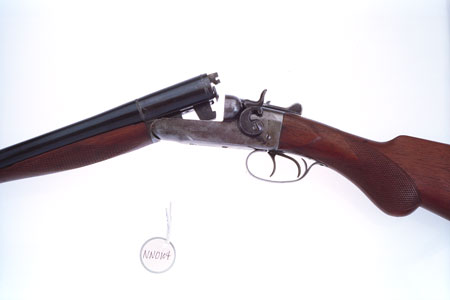
Question:
Stamped on the Stevens Model 355, and its successor Model 335 hammerless boxlock guns, I see the patent date Mar 19,1907. On the Stevens Model 330 and Riverside No. 315 and Springfield No. 311, which are also boxlock hammerless models, I see stamped the words Patented April 20, 1915. On some Stevens' Riverside No. 215 hammer doubles is stamped Patented Feb 10,1914 . Were these Patents owned by Stevens? What features do these patents protect. and when were these patent dates stamped on the guns? Knowing this would help me to identify models and estimate their dates of manufacture. As you know, because no Savage ( including Savage/Stevens/Fox/ Baker/Davis/Crescent) factory production records have survived, getting a sure fix on Stevens doubles' models and dates can be difficult. Did these patents issue on the dates noted or did they take effect when the patents were ‘applied for'? Did they expire after 17 years? Hope this is within your realm of expertise. Thank you. FS
Answer:
Interesting question! I have researched this and can try to offer you some information on patents used by Stevens. Remember, the patents were good, unless invalidated, for 17 years after being granted. Sometimes the patent application process was ‘dragged out' to keep the patented invention under control of the owner for a longer period. Dates and brief descriptions of the three Stevens patents you mention in your letter follow. These were very important patents to Stevens!:
March 19,1907 = #847,659 Ed Elder to J Stevens A&T Co. cocking lever trigger plate on hammerless boxlocks 1907-1914 Stevens (335, 365), also “Pat appl'd for” 2 years previous to 1907.
February 10,1914 = # 1,086,378 George S Lewis to J Stevens A&T Co. plunger strikers (firing pins) with coil springs and pivoted triggers on hammer boxlocks, 1914 -1928 and “Pat appl'd for” two years previous to 1914. Models Stevens (225), Riverside (215).
April 20,1915 = #1,136,247 George S Lewis to J Stevens A&T Co. one piece cast frame, combination cocking lever and extractor on hammerless boxlocks 1915-1932, doubles stamped “Pat appl'd for” and ‘patent pending' several years before 1915: Models marked: Riverside (311,315) Springfield (311,315), Stevens, Eastern Arms , Central Arms, many other private brands.
This 1915 patent was most significant because it covered both the combination (one piece) sliding extractor-‘comb' shaped cocking piece with coil-spring powered striker firing mechanism used by Stevens in all their hammerless doubles from 1914 to 1933 (Riverside 315, Springfield 311 and 3151, Stevens Model 330 and 331 etc) and the one piece ‘hollow' frame which carried the critical parts of the mechanism (hammers and sears) on horizontal pins. This was a unique system, reliable in use and inexpensive to build. The ‘comb' extractor cocker was much easier to make and fit than the parts which performed the same operations in other guns of that era. It was a genial design.
The system that followed it appears not to have been patented. This was the ‘spade' shaped rod, which being first introduced in the “Springfield” line in 1932, was not used on Stevens brand doubles until the introduction of the Stevens Model 530 in 1932. This ‘spade' shaped rod slid down diagonally in the barrel lug (against a spring in later models) to simultaneously actuate the extractor and lift the hammer toes on the internal hammers which succeeded the coil spring powered strikers of the ‘comb' system. I mention it because it owes a lot to Lewis' earlier inventions, especially the one-piece cast frame. Beginning about 1933, and until 1988 when they stopped making them, all Stevens doubles employed the ‘spade' cocker-extractor system with internal hammers. Both systems depended on a movable stud on the fore end iron which, when the fore end iron was assembled to the gun, pushed the ‘comb' or ‘spade' into engagement with the lever(s) which cocked the strikers or hammers, respectively.
George S. Lewis worked for J. Stevens A&T Co from 1909 to 1920. His inventions provided the major designs for Stevens hammer and hammerless boxlock guns. Long after his patents expired, Stevens doubles were based on his work. Only Louis Elkas had such a positive effect on Savage/Stevens designs. Lewis later worked for WRA Co's New Haven Works Manager, Ed Pugsley, who was spearheading John M.Olin's effort to produce the Model 21 double gun started by his predecessor, T.G. Bennett (Oliver Winchester's son-in-law) and famed designer T.C. Johnson.
Another inventor who was very important to Stevens was Andrew E Whitmore. Remington owned and used his sliding rod lockup for their guns in the 1880s, but Stevens also used it on their hammer boxlock Model 325 introduced about 1903. Stevens stamped the left side of the Model 325 frame “Pat s Appl'd For”, but maybe that referred to other patents (note the plural), because the Whitmore 1874 patent would have expired in 1891 and Stevens would have been able to use it freely. Stevens did replace the Whitmore locking system with a much simpler extension notch lock up in their second version of the 325 about 1905.
The Stevens Model 325 was dropped altogether in 1908 but it had ushered in a new era of simpler, stronger, cheaper boxlock doubles which the shooting public trusted and liked. It was the beginning of Savage/Stevens' dominance of the ‘affordable' double gun market in America.

Next Step: Get your FREE Printable Target Pack
Enhance your shooting precision with our 62 MOA Targets, perfect for rifles and handguns. Crafted in collaboration with Storm Tactical for accuracy and versatility.
Subscribe to the Gun Digest email newsletter and get your downloadable target pack sent straight to your inbox. Stay updated with the latest firearms info in the industry.







